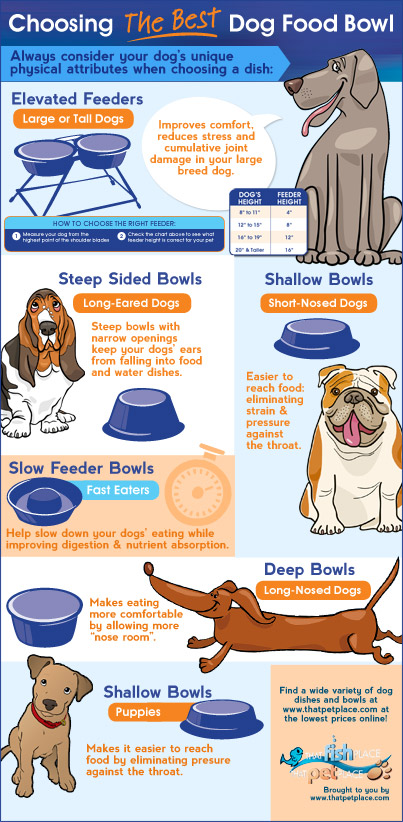If you’ve recently walked down the dog bowl aisle, you’ll know that there are dozens of different sizes and shapes of dog bowls available to choose from. What you might not know is that the different shapes now available are specifically manufactured to meet the specific needs of different dog breeds and age groups. Here at That Pet Place we’ve put together a handy infographic to help you with choosing the right dog bowl that is the perfect match for your pet!
Elevated Dog Dishes
Elevated dog bowls are usually best suited for large or tall dogs, which are prone to back and neck problems. They can also aid smaller dogs who have posture problems, those who tend to ingest a lot of air while eating and aid digestion. Be sure to choose the right height feeder for your pet by measuring your dog’s height (measured from the highest point of the shoulder blades to the ground).
| Dog’s Height | Feeder Height |
| 8 – 11 inches | 4 inches |
| 12 – 15 inches | 8 inches |
| 16-19 inches | 12 inches |
| Over 19 inches | 16 inches |
Bowls with Narrow Openings
Angled dog bowls, or dog bowls that are sloped with a narrow opening and wide base, are most appropriate for dogs with long ears or long fur that tends to fall into their food or drink, creating a mess and unruly tangles. Look for bowls with openings that are narrower than the base, but not too narrow that your dog’s snout will not fit into it comfortably.
Shallow Bowls
Shallow dog bowls are best for short-nosed or flat faced breeds (also known as brachycephalic breeds). Some examples would include Bulldogs, Pugs and Pekingese breeds. These dogs often experience breathing problems and partial obstruction of the upper respiratory system. Shallower bowls make it easier for your pet to reach their food and eliminates the strain and pressure higher bowls might put on the throat and airway.
Shallow bowls are also generally more appropriate for small puppies for many of the same reasons.
Deep Dog Dishes
Deep dog bowls are appropriate for dogs who have extended or elongated noses, resulting in a more comfortable and natural experience. Common breeds with an elongated snout or muzzle include Collies, Shelties, Dachshunds and Wolfhounds.
Slow Feeder Dog Bowls
If you’ve got a dog that seems to “wolf” down their food, a slow feed dog bowl is the one for you. Many dogs eat so quickly, that it seems that they aren’t chewing their food at all. This practice is common in multi-dog households (this is definitely the case in my household). Sometimes this gulping leads to regurgitation of the food shortly after dinner, excessive gas and occasionally contributes to the deadly condition known as bloat. Slow feed bowls usually have one or more obstacles in the bowl (such as high bumps) that your pet has to navigate their snout around, preventing your dog from virtually inhaling their food. Slowing down your dog’s eating also helps to prevent choking while improving digestion and nutrient absorption.
Hopefully this blog post will help you navigate the wide variety of dishes in the dog bowl aisle the next time you’re shopping for a new dish for your pooche(s). If you have any questions or comments, we’ve love to have you sound off in the below!
 That Pet Blog That Pet Place Pet Blog
That Pet Blog That Pet Place Pet Blog


